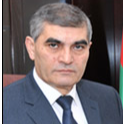
Rashid G. Alakberov
Work place: Institute of Information Technology, Baku, AZ1141, Baku, Azerbaijan
E-mail: rashid.alakberov@gmail.com
Website:
Research Interests: Distributed Computing, Computer Networks,
Biography
Rashid G. Alakbarov graduated from Automation and Computer Engineering faculty of Azerbaijan Polytechnic University named after C. Ildirim. He received his PhD degree in 2006 from Supreme Attestation Commission under the President of the Republic of Azerbaijan. His primary research interests include various areas in cloud computing, data processing, computer networks, virtual computing, particularly in the area of distributed computing. He is head of department at the Institute of Information Technology as of 2002. Since 2010, he has been leading the development of “AzScienceNet” infrastructure. In 2021, he was appointed an executive director of the institute by the decision of the Presidium of Azerbaijan National Academy of Sciences. He is the author of 95 scientific papers, inclouding 5 inventions.
Author Articles
Clustering Method of Mobile Cloud Computing According to Technical Characteristics of Cloudlets
DOI: https://doi.org/10.5815/ijcnis.2022.03.06, Pub. Date: 8 Jun. 2022
The rapid increase in the number of mobile phones and IoT devices connected to the network reduces the bandwidth of the Internet communication channel, and as a result, delays occur in the delivery of data processed in remote clouds. Edge computing systems (cloudlet, fog computing, etc.) are used to eliminate resource shortages, energy consumption, and communication channel delays in mobile devices. Edge computing systems place processing devices (computers) close to users. Cloudlet-based mobile cloud computing is widely used to reduce delays in communication channels and energy consumption in mobile devices. Selection of the most suitable cloudlet allowing users to run applications fast in cloud is still a considerable problem. This paper proposes a strategy for the selection of high-performance cloudlets providing fast solutions, considering the complexity of application (file type). It offers a method for cloudlet selection out of large number of cloudlets with different technical capabilities providing faster processing of user application. The timing of user applications in cloudlets with different technical capabilities (operating frequency, number of cores, volume of RAM, etc.) also varies. The proposed method provides faster solution for the user application. User applications are grouped by type of application, and a set of cloudlets are clustered by the number of groups. Clustering is performed first by the parameters corresponding to the operating frequency of the cloudlets, then by the number of cores and the volume of RAM. The proposed method reduces energy consumption of mobile devices by providing faster processing of applications. Thus, the proposed strategy provides an energy consumption reduction on mobile devices, faster processing of results and decrease of network delays.
[...] Read more.Other Articles
Subscribe to receive issue release notifications and newsletters from MECS Press journals